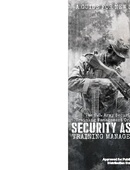
The Center for Army Lessons Learned leads the Army Lessons Learned Program and delivers timely and relevant information to resolve gaps, enhance readiness, and inform modernization.

Downloads: 1244
Hits: 1244
Security Assistance Team (SAT) Managers manage non-institutional Security Assistance training programs for countries within a designated region of the... read more
Security Assistance Team (SAT) Managers manage non-institutional Security Assistance training programs for countries within a designated region of the world. This handbook is written for the newly assigned SAT Manager as well as for U.S. embassy country team Security Cooperation Organizations with whom SAT Managers interact daily.
less

Downloads: 1288
Hits: 1288
This article meets the U.S. Army and CAC Commander requirement to promulgate information on sUAS tactics, techniques, and procedures, capabilities and... read more
This article meets the U.S. Army and CAC Commander requirement to promulgate information on sUAS tactics, techniques, and procedures, capabilities and vulnerabilities of drones... in this case related to fiber optic spool-fed sUAS. Fiber optic drones, including FPVs, present a unique challenge on the battlefield in that they emit minimal EM signatures, and they are very difficult to interdict and defeat via Electronic Warfare systems and C-sUAS capabilities. This article presents some of the latest open source findings related to fiber optic spool-fed drones, essential for every Soldier to understand.
less

Downloads: 1304
Hits: 1304
This article outlines a recent study assessing 3-8 CAV performance of tank and Bradley crews at Gunnery Table 6, aiming to improve training and operational... read more
This article outlines a recent study assessing 3-8 CAV performance of tank and Bradley crews at Gunnery Table 6, aiming to improve training and operational effectiveness. Utilizing both quantitative data (training records, performance metrics) and qualitative interviews with top and bottom-performing crews, the research identified resilience and vehicle maintenance proficiency as key performance indicators (KPIs) significantly impacting success.
The study revealed a need to re-weight these KPIs in self-assessment, as crews who rated themselves highly in these areas consistently performed better. Lower scores overall were attributed to recent NCO turnover and the rapid promotion of junior Soldiers.
Recommendations focus on a DOTMLPF-P framework: refining doctrine for crew certification (annual proficiency exams), expanding master gunner roles, incorporating more realistic training scenarios (stress shoots, degraded environments), improving digital tracking systems, and targeted leader development. Addressing NCO turnover through cross-training and phased transitions is also crucial. Ultimately, the study emphasizes a holistic approach to enhance crew lethality and readiness.
less

Downloads: 1253
Hits: 1253
This article explores the evolving role of power generation in LSCO arguing that energy must be treated as an equal commodity on par with CLIII Fuel and CLV... read more
This article explores the evolving role of power generation in LSCO arguing that energy must be treated as an equal commodity on par with CLIII Fuel and CLV Munitions. Drawing on lessons learned from Recent Joint Pacific Multinational Readiness Center (JPMRC) and Lethal Eagle exercises, the article highlights how distributed operations, unmanned systems, and sensor rich formations are driving unprecedented battlefield energy demand. It examines current gaps in power distribution, storage and sustainment planning, and proposes an echeloned approach to power support complete with modular energy packages, scalable charging infrastructure, and formalized tracking systems. The central thesis: in LSCO, energy is not a convenience, it’s a combat enabler. If we fail to treat it as such, we risk operational paralysis at the edge of the fight.
less

Downloads: 1201
Hits: 1201
For the last twenty years of Counterinsurgency (COIN) operations, the Army Medical Community has enjoyed unprecedented medical evacuation of wounded from... read more
For the last twenty years of Counterinsurgency (COIN) operations, the Army Medical Community has enjoyed unprecedented medical evacuation of wounded from the battlefield. Air superiority allowed for Army aviation to evacuate from the point of injury to definite care in little as 20 minutes. From the lessons learned as a result of the Russian-Ukraine conflict, we know now this might not be the case in the future. In any future Large Scale Combat Operations, US air superiority will not be guaranteed; in addition, the use of UaS that we are seeing in Ukraine, could degrade the use of dedicated ground evacuation of causalities. The Ukrainian military medical community in partnership with civilian industry has develop a Role 2 underground “Sustainment Points” to allow prolong medical care of wounded. This paper explores how Ukraine developed and uses these system along with the potential for employment by the US Medical Community in future LSCO.
less

Downloads: 223
Hits: 223
This handbook is designed to provide junior NCOs a roadmap to success to navigate their 1st 100 Days. There are a number of topics they need to be aware as... read more
This handbook is designed to provide junior NCOs a roadmap to success to navigate their 1st 100 Days. There are a number of topics they need to be aware as they become young leaders and the base of the NCO CORPS, the backbone of the Army.
less







